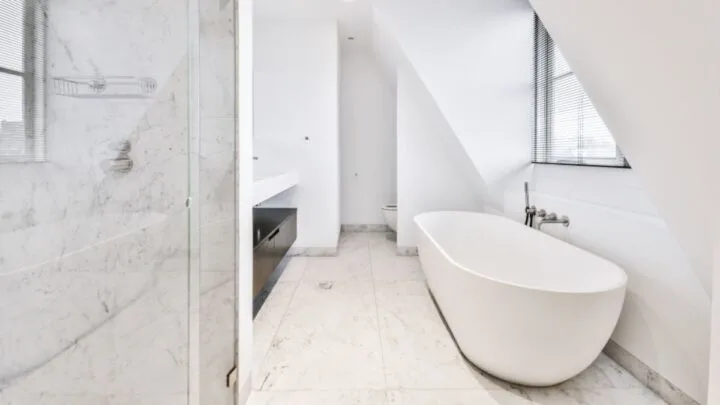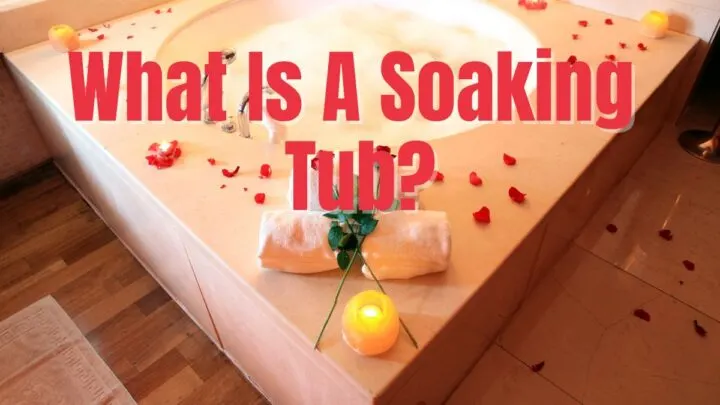A soaking tub is defined by several characteristics, such as the material used in construction, depth, length, and the features it is equipped with.
A soaking tub can best be defined as a bathtub that is deeper than the normal bathtub, allowing you to be more deeply submerged in water, which allows for more relaxation benefits.
Once a luxury form of bathing, soaking tubs have become favorites!
With owners looking to take a relaxing, therapeutic soak without having the tops of their knees exposed to the air as they squat in compact bathtubs!
Table of Contents
The Differences Between A Regular And A Soaking Tub
Depth
The first primary difference between a regular bathtub and a soaking tub is its depth!
Regular tubs allow you to lay down or squat horizontally while soaking tubs easily accommodate an average-sized person completely immersed in water.
The depth of water in a standard bathtub can be 1.5-2 feet maximum while soaking tubs start at anywhere around 2 feet in depth and can be deeper than that as well.
Functionality
The functions of the two different tubs are very dissimilar, hence the difference in their construction.
A regular bathtub is a common site in most bathrooms and allows you to relax and lay back, with your favorite bubble baths and bath oils providing a therapeutic function.
The healing and relaxing effect of soaking tubs is achieved via your entire body being submerged in warm water, but in some models, you cannot use bath salts and bath bombs for fear of clogging the hot water vents.
Regular tubs can easily permit shower heads and other fittings as installations to become a more multi-purpose space, but soaking tubs are more restrictive because they occupy most of the space in which they are installed.
A general drop-in tub requires a recess or a space in your bathroom, while most free-range, modern soaking tubs can be installed in any convenient place where there is space.
Kinds And Shapes Of Soaking Tubs
Soaking tubs come in many different shapes, colors, and styles, making them adaptable to any aesthetic you have going on in your house- minimalist, vintage, chic, and much more.
Some common types of soaking tubs are:
- Freestanding Tub: The favorite of modern, minimalistic interior designers, these tubs are attached to the floor away from a wall. Celebrities like Kim Kardashian have flaunted their freestanding soaking tubs.
- Drop-In: These soaking tubs are installed into a structure built to contain the tub, with the “overmount” rim of the tub as the only part showing through the level surface.
- Corner Tubs: These are created to configure your bathtub space snugly into your bathroom shape. Whether rectangular or oval, corner tubs are fitted into a corner of your bathroom.
- Alcove Tubs: These are all the rage in modern, maximalist bathroom structures and are canopied on all three sides by a wall, guaranteeing you privacy and a space where you can snugly take a bath.
- Walk-in Tubs: These are perfect for ensuring minimum slippage if you are installing a soaking tub in a house of kids since it eases their going in and out of the tub. Some walk-in tubs have door structures for the physically disabled to be able to bathe in all comfort without having to clamber in.

Shapes and Materials
The shape of a soaking tub can be left entirely up to your discretion.
You can have a soaking tub installed in a round, square, oval, rectangular, slipper, hourglass, or clawfoot style and shape per your bathroom aesthetic.
The common materials used in the construction of soaking tubs are traditional ceramics, which come in a multitude of colors and patterns.
If you are focused on aesthetics, you can install a luxury wood bath, but it requires you to spend a pretty penny on maintenance as well as initial installation costs.
Stone resin is becoming more and more common as a construction material for tubs since they are very good at retaining heat, is comparatively cheap, and is malleable to the style and color you want for your soaking tub.
How To Install A Soaking Tub
Installing a soaking tub is way easier when compared to the complicated pipeline fittings required for appliances like jetted tubs.
As freestanding tubs, you simply have to make sure the place of installation can carry the weight of the tub, isn’t impeding the space in your bathroom, and is in close proximity to a water source.
Simply connect the pipe fittings and taps close to the tub, install it, and you are done!
However, there are steps to this process where you will need a couple more people to help you, such as carrying the tub to the requisite space before installation.
Make sure the plumbing is in place before you place the tub in the space since soaking tubs are generally heavy, and it’s a hassle to move them repeatedly.
Soaking Tub FAQs
What Is the Difference Between a Soaking Tub and a Regular Tub?
A soaking tub is deeper than a regular bathtub, allowing for a full body immersion in water.
Soaking tubs are designed to create a spa-like experience, whereas regular tubs are primarily used for quick bathing.
To learn more, make sure to take a look at my full article on the differences between a soaking and a regular bathtub.
Why Are Soaking Tubs So Popular?
Soaking tubs are popular because they provide a relaxing and therapeutic experience. They can help reduce stress, alleviate muscle tension, and improve circulation.
Soaking tubs also add a luxurious and stylish element to a bathroom!
To see my full list of all 7 reasons, make sure to take a look at my dedicated post on why soaking tubs are so popular.
Are Soaking Tubs Comfortable?
Soaking tubs can be very comfortable, especially if they are designed with ergonomic features such as neck support and armrests.
However, comfort is always subjective and may depend on the individual’s preferences.
If you’d like to learn more about the nuances of what makes particular types of soakers comfortable, look at my full article on are soaking tubs comfortable.
What Is A Good Size For A Soaking Tub?
A good size for a soaking tub is typically around 60 inches long, 32 inches wide, and 22 inches deep.
However, the size can vary depending on the individual’s needs and the space available in the bathroom.
To learn more about choosing the right size soaking tub for your bathroom, take a look at my dedicated article on what is a good size for a soaking tub.
Do Soaking Tubs Have Heaters?
Some soaking tubs come with built-in heaters, which allow the water to stay warm for a longer period of time.
However, not all soaking tubs have heaters, so it is important to check the specifications before purchasing!
To learn more about the various types of soaking tubs with heaters, make sure to take a look at my post on do soaking tubs have heaters.
Do Soaking Tubs Have Jets?
Sadly, not all soaking tubs have jets!
While some models may have built-in air or water jets, others are designed to simply hold hot water for soaking.
To learn more about what features might be included to replace jet action, make sure to take a look at my post on do soaking tubs have jets!
What Is A Japanese Soaking Tub?
A Japanese soaking tub, also known as an “ofuro,” is a type of soaking tub that originated in Japan.
They are typically smaller and deeper than traditional Western-style tubs and are designed to be filled with very hot water.
To learn more about the history and benefits of Japanese soaking tubs, make sure to take a look at my post on what is a Japanese soaking tub.
Are Soaking Tubs Really Worth It?
The worth of a soaking tub depends on individual preferences and needs!
If relaxation and luxury are important to someone and they have space in their bathroom and budget, a soaking tub can be a great investment. However, if quick showers are more practical, a soaking tub may not be worth the investment.
To learn more about whether or not you’d get the most value out of a soaking tub, make sure to take a look at my article on are soaking tubs worth it.
Summing Up What Are Soaking Tubs
It’s important to note certain things before investing in a soaking tub. Just simply going for aesthetic and visual appeal isn’t enough!
You first need to make sure your space is conducive to installing a soaking tub.
As a financial investment, it can be a bit more on the pricey side and requires maintenance frequently, which has to be another cost you have to account for.
Furthermore, soaking tubs are not suitable for younger kids, as the depth can prove to be a drowning hazard.
Otherwise, for therapeutic bath times, adaptability to your space, and visual appeal, soaking tubs have a lot of commendable qualities.


